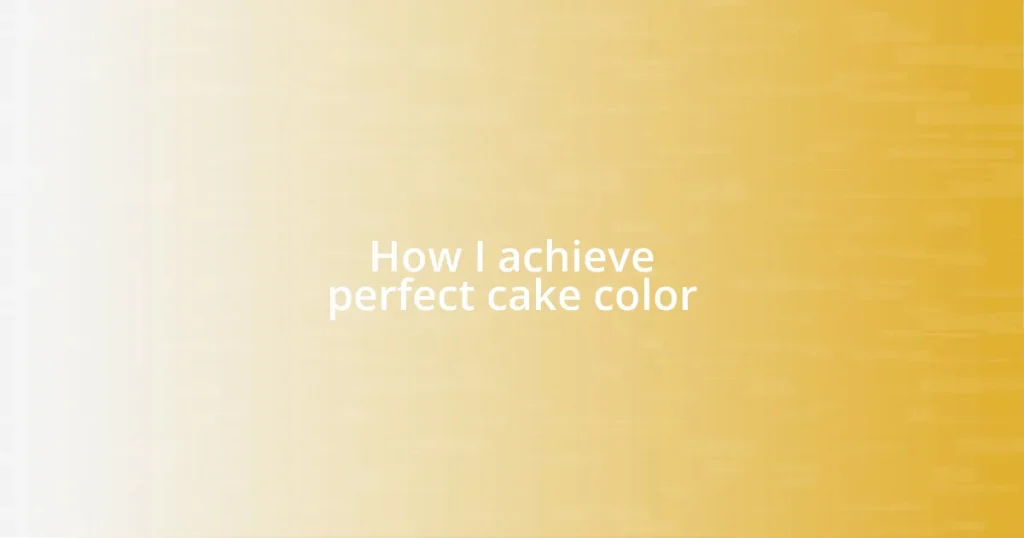Key takeaways:
- Color affects both the aesthetic appeal and perceived taste of cakes, requiring careful choice of coloring methods.
- Using high-quality ingredients and natural colorings can enhance both the visual and flavor aspects of the cake.
- Thorough mixing, ingredient temperature, and proper baking methods are essential for achieving even color in cakes.
- Environmental factors, such as humidity, and proper storage can significantly impact the vibrancy of cake color over time.

Understanding cake color basics
When diving into the world of cake color basics, it’s fascinating to remember that color isn’t just about aesthetics; it impacts how we perceive taste too. Have you ever noticed how a deep chocolate cake can evoke a sense of richness and indulgence even before you take the first bite? That emotional connection to color is something I experienced firsthand when I once made a vibrant, sunny lemon cake for a friend’s birthday. The sheer brightness instantly lifted the mood of the room; it’s a perfect reflection of the joy that good cake can bring.
Understanding the different types of colorings available is crucial in achieving your desired hue. I’ve often found myself standing in the baking aisle, bewildered by the array of options—from gel food coloring to natural alternatives like beet juice or turmeric. Each type offers unique outcomes. For instance, using gel food coloring results in more vivid colors without altering the cake’s consistency, while natural colors can provide softer, more pastel shades. Have you ever experimented with these different options?
As I’ve experimented with various color combinations, I realized that the balance is key. A drop too much of blue can turn a cheerful yellow cake into an unexpected shade of green! It’s an intriguing lesson in precision that I’ve learned through trial and error. What about you? Do you have a favorite color combination that has become your signature go-to?

Choosing the right ingredients
When selecting the right ingredients for your cake, quality matters immensely. I remember the time I used fresh eggs from a local farm, and the color of my cake batter was a vibrant yellow that left me in awe. It’s that freshness that significantly influences both color and flavor. For those curious about how different brands might impact your cake, consider experimenting with premium versus regular ingredients; the difference can be striking.
Natural food colorings have been a revelation in my baking journey. One time, I used pureed raspberries for a cake, and the result was a lovely, rosy hue that not only looked gorgeous but also tasted divine. It’s enchanting how these natural options can enhance both the visual and sensory aspects of your cake. However, it’s essential to keep in mind that some natural colorings, like beet juice, may alter not just the cake’s shade but also its flavor profile, unlike artificial colorings, which usually remain neutral.
Here’s a handy comparison table that might help you decide which ingredients to use for achieving that perfect cake color:
| Ingredient | Impact on Color |
|---|---|
| Gel Food Coloring | Vivid, concentrated colors |
| Natural Colorings (like beet juice) | Soft, earthy tones; may affect flavor |
| Cocoa Powder | Rich brown, can overshadow other colors |
| Egg Yolks | Adds a warm yellow hue |
| Fruit Purees | Natural colors, vibrant yet subtle |

Mixing colors for desired shades
Mixing colors requires an understanding of how different hues can transform your cake from ordinary to extraordinary. I vividly recall my first attempt to achieve a stunning lavender cake. I mixed a drop of blue gel coloring with a hint of violet, and the moment I whipped it into the batter, the shade blossomed beautifully. It was such an emotional experience seeing the transformation, and it reminded me how a little creativity can go a long way.
When mixing shades, consider these essential tips to achieve your desired color:
- Start small: Use tiny amounts of food coloring, as a little goes a long way.
- Layer colors: Mix slowly, adding one color at a time to control the outcome.
- Test before use: Always test your mixed color on a small amount of batter or frosting to see the final effect.
- Keep notes: Document your recipes and color combinations for future reference—this will become invaluable.
- Know your base: Remember that the color of your cake batter can affect the final product; a yellow batter will always yield a different outcome than a white one, even with the same red food coloring.
The joy of experimenting is what makes baking so fulfilling!

Techniques for achieving even color
To achieve even color in your cake, thorough mixing is essential. I once baked a marble cake that looked splendid but tasted uneven; the hidden patches were a disappointment. This experience taught me that blending the batter until it’s harmonious ensures a consistent color throughout, setting a solid foundation for an eye-catching cake.
Another technique I’ve found beneficial is to sift your dry ingredients together before adding them to the wet mixture. I remember the first time I made a bright red velvet cake; the smooth integration of cocoa powder and flour prevented any clumps that could have caused uneven coloring. Plus, it’s a quick trick that not only brightens the hue but also enhances the texture—who wouldn’t want that?
Lastly, consider temperature when mixing. Have you ever wondered how the temperature of your ingredients can affect color? I used to leave my butter out too long, and it would warm up too much, leaving my cake with a dull, uneven color. Now, I make sure my ingredients are at room temperature, striking that perfect balance for even mixing, which ultimately leads to a vibrant cake every time!

Adjusting color with baking methods
When it comes to adjusting color with different baking methods, I’ve found that even the simplest techniques can yield surprising results. For instance, using tools like a water bath can allow for even baking, ensuring that the outer layer of a cake does not over-bake and darken while the inside remains pale. I recall baking a chocolate cake this way and being amazed at how the rich color came out uniform and inviting, without any burnt edges to mar its appearance.
Additionally, the type of pan you use can significantly influence the final hue of your cake. I used to always choose aluminum pans, but when I switched to dark non-stick pans, the color of my cakes deepened beautifully. Have you ever noticed how a chocolate cake baked in a dark pan looks richer? It’s all about how the pan absorbs and redistributes heat, impacting the reaction of the batter as it transforms in the oven.
Lastly, consider the baking temperature. I once forgot to lower the heat for a batch of pastel cakes and ended up with a vibrant, albeit slightly overcooked result. That taught me that baking at the right temperature not only helps in achieving a lighter color for delicate cakes but also preserves the brightness of your chosen hues. It seems so simple, but maintaining a steady temperature is key to ensuring that your cake reflects exactly the shade you envisioned.

Troubleshooting color issues
When troubleshooting color issues, one common problem I’ve encountered is that sometimes cakes can appear too dark or too light after baking. I remember a time when I attempted a lemon cake, only to find that the bright yellow batter turned out almost brown at the edges. It was frustrating and made me wonder if it was the baking time or the oven temperature. I realized that calibrating my oven and keeping an eye on baking time made a huge difference. A quick check with an oven thermometer can save you from color disasters.
Another aspect to consider is the type of colorants you’re using. I learned this the hard way during my chocolate layer cake saga—where I thought using a natural cocoa powder would yield a rich, dark color. Instead, it turned out muted and didn’t have the vibrant look I was hoping for. The lesson here is straightforward: sometimes, high-quality food coloring or gel dyes can bring a pop of color that natural ingredients can’t achieve. Have you ever noticed how some food colors seem to shine much brighter? It’s all about the formulation and their interaction with your ingredients.
You might also find that humidity can impact color, which surprised me at first. On a particularly muggy day, I once baked a carrot cake that had a dull finish, despite my usual techniques. It led me to experiment with slightly adjusting the flour measurements to account for that extra moisture in the air. This little tweak not only enhanced the color but also improved the overall texture. How often do we think about environmental factors affecting our baking? It’s a fascinating aspect that can truly change the game when you’re in pursuit of that perfect cake hue.

Tips for maintaining vibrant color
Maintaining vibrant cake color can sometimes feel like a juggling act, but I’ve discovered a few tricks that consistently yield great results. For instance, when I whipped up a vivid red velvet cake, I made sure to mix in my food coloring gradually, checking the hue as I went along. Have you ever gone overboard with color, only to end up with a shade that’s a bit overwhelming? It’s definitely better to start small and build, as you can always add more.
Another useful tip is to keep your ingredients at room temperature. I can’t tell you how many times I’ve noticed a difference in color when butter and eggs were too cold. Once, while preparing a vanilla cake, I used chilled eggs, and the batter took on this odd, muted tone instead of the bright yellow I aimed for. Getting your ingredients to room temperature can promote better emulsification, leading to a more vibrant end result. Isn’t it fascinating how something so simple can have such a big impact?
Lastly, I’ve found that proper storage is essential for keeping my cakes looking their best. After decorating a stunningly vibrant cake for a friend’s birthday, I mistakenly stored it in direct sunlight, which faded its colors. It was disheartening to see my hard work diminish. Now, I always make it a point to store my cakes in a cool, dark place, ensuring that they maintain their lively appearance until the moment they’re sliced. What good is a beautiful cake if its color doesn’t last?















